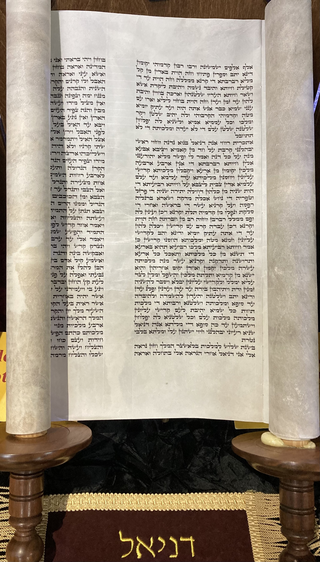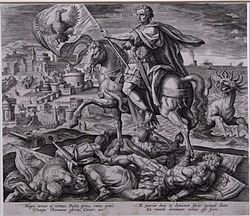
The Book of Daniel is a biblical apocalypse authored during the 2nd century BC, and set during the 6th century BC. The work describes "the activities and visions of Daniel, a noble Jew exiled at Babylon"; in doing so, it interpolates a portrayal of a historical prophecy being fulfilled with a prediction of future cosmic and political upheaval. This eschatology ultimately affirms that the God of Israel's previous deliverance of Daniel from his enemies prefigures his future deliverance of the people of Israel from their present oppression.

Yahweh was an ancient Levantine deity, and national god of the Israelite kingdoms of Israel and Judah. Though no consensus exists regarding the deity's origins, scholars generally contend that Yahweh is associated with Seir, Edom, Paran and Teman, and later with Canaan. The origins of his worship reach at least to the early Iron Age, and likely to the Late Bronze Age, if not somewhat earlier.

Apocalypse is a literary genre in which a supernatural being reveals cosmic mysteries or the future to a human intermediary. The means of mediation include dreams, visions and heavenly journeys, and they typically feature symbolic imagery drawn from the Hebrew Bible, cosmological and (pessimistic) historical surveys, the division of time into periods, esoteric numerology, and claims of ecstasy and inspiration. Almost all are written under pseudonyms, claiming as author a venerated hero from previous centuries, as with the Book of Daniel, composed during the 2nd century BC but bearing the name of the legendary Daniel.
The oldest surviving Hebrew Bible manuscripts, the Dead Sea Scrolls, date to c. the 2nd century BCE. Some of these scrolls are presently stored at the Shrine of the Book in Jerusalem. The oldest text of the entire Bible, including the New Testament, is the Codex Sinaiticus dating from the 4th century CE, with its Old Testament a copy of a Greek translation known as the Septuagint. The oldest extant manuscripts of the vocalized Masoretic Text date to the 9th century CE. With the exception of a few biblical sections in the Nevi'im, virtually no biblical text is contemporaneous with the events it describes.
The Prophecy of Seventy Weeks is the narrative in chapter 9 of the Book of Daniel in which Daniel prays to God to act on behalf of his people and city, and receives a detailed but cryptic prophecy of "seventy weeks" by the angel Gabriel. The prophecy has been the subject of "intense exegetical activity" since the Second Temple period. James Alan Montgomery referred to the history of this prophecy's interpretation as the "dismal swamp" of critical exegesis.

"Abomination of desolation" is a phrase from the Book of Daniel describing the pagan sacrifices with which the 2nd century BC Greek king Antiochus IV Epiphanes replaced the twice-daily offering in the Jewish temple, or alternatively the altar on which such offerings were made.

Darius the Mede is mentioned in the Book of Daniel as King of Babylon between Belshazzar and Cyrus the Great, but he is not known to secular history and there is no space in the historical timeline between those two verified kings.

Daniel 2 tells how Daniel related and interpreted a dream of Nebuchadnezzar II, king of Babylon. In his night dream, the king saw a gigantic statue made of four metals, from its head of gold to its feet of mingled iron and clay; as he watched, a stone "not cut by human hands" destroyed the statue and became a mountain filling the whole world. Daniel explained to the king that the statue represented four successive kingdoms beginning with Babylon, while the stone and mountain signified a kingdom established by God which would never be destroyed nor given to another people. Nebuchadnezzar then acknowledges the supremacy of Daniel's God and raises him to high office in Babylon.
Daniel 7 tells of Daniel's vision of four world-kingdoms replaced by the kingdom of the saints or "holy ones" of the Most High, which will endure for ever. Four beasts come out of the sea, the Ancient of Days sits in judgment over them, and "one like a son of man" is given eternal kingship. An angelic guide interprets the beasts as kingdoms and kings, the last of whom will make war on the "holy ones" of God, but they will be destroyed and the "holy ones" will be given eternal dominion and power.

Shadrach, Meshach, and Abednego are figures from chapter 3 of the biblical Book of Daniel. In the narrative, the three Jewish men are thrown into a fiery furnace by Nebuchadnezzar II, King of Babylon for refusing to bow to the king's image. The three are preserved from harm and the king sees four men walking in the flames, "the fourth ... like a son of God". They are first mentioned in Daniel 1, where alongside Daniel they are brought to Babylon to study Chaldean language and literature with a view to serving at the King's court, and their Hebrew names are replaced with Chaldean or Babylonian names.
There is much disagreement within biblical scholarship today over the authorship of the Bible. The majority of scholars believe that most of the books of the Bible are the work of multiple authors and that all have been edited to produce the works known today. The following article outlines the conclusions of the majority of contemporary scholars, along with the traditional views, both Jewish and Christian.

Daniel is the main character of the Book of Daniel. According to the Hebrew Bible, Daniel was a noble Jewish youth of Jerusalem taken into captivity by Nebuchadnezzar II of Babylon, serving the king and his successors with loyalty and ability until the time of the Persian conqueror Cyrus, all the while remaining true to the God of Israel. While some conservative scholars hold that Daniel existed and his book was written in the 6th century BCE, most scholars agree that Daniel is not a historical figure and that much of the book is a cryptic allusion to the reign of the 2nd century BCE Hellenistic king Antiochus IV Epiphanes.
Chapters 10, 11, and 12 in the Book of Daniel make up Daniel's final vision, describing a series of conflicts between the unnamed "King of the North" and "King of the South" leading to the "time of the end", when Israel will be vindicated and the dead raised, some to everlasting life and some to shame and everlasting contempt.

The origins of Judaism lie in Bronze Age polytheistic Canaanite religion. Judaism also syncretized elements of other Semitic religions such as Babylonian religion, which is reflected in the early prophetic books of the Hebrew Bible.
John J. Collins is an Irish-born American biblical scholar, the Holmes Professor of Old Testament Criticism and Interpretation at Yale Divinity School. He is noted for his research in the Hebrew Bible, as well as the apocryphal works of the Second Temple period including the sectarian works found in Dead Sea Scrolls and their relation to Christian origins. Collins has published and edited over 300 scholarly works, and a number of popular level articles and books. Among his best known works are the Between Athens and Jerusalem: Jewish Identity in the Hellenistic Diaspora ; Daniel in the Hermeneia commentary series ; The Scepter and the Star. The Messiahs of the Dead Sea Scrolls and Other Ancient Literature ; and The Bible after Babel: Historical Criticism in a Postmodern Age.

Daniel 1 tells how Daniel and his three companions were among captives taken by Nebuchadnezzar II from Jerusalem to Babylon to be trained in Babylonian wisdom. There they refused to take food and wine from the king and were given knowledge and insight into dreams and visions by God, and at the end of their training they proved ten times better than all the magicians and enchanters in the kingdom.

Daniel 4, the fourth chapter of the Bible's Book of Daniel, is presented in the form of a letter from king Nebuchadnezzar II in which he learns a lesson of God's sovereignty, "who is able to bring low those who walk in pride". Nebuchadnezzar dreams of a great tree that shelters the whole world, but an angelic "watcher" appears and decrees that the tree must be cut down and that for seven years, he will have his human mind taken away and will eat grass like an ox. This comes to pass, and at the end of his punishment, Nebuchadnezzar praises God. Daniel's role is to interpret the dream for the king.

Zechariah 1 is the first chapter of the Book of Zechariah in the Hebrew Bible or the Old Testament of the Christian Bible. This book contains the prophecies attributed to the prophet Zechariah, and is a part of the Book of the Twelve Minor Prophets. As the first of the 14 chapters in the book, this chapter is a part of a section consisting of Zechariah 1-8. It records an introduction and the first two of eight visions received by the prophet.

Ezra 1 is the first chapter of the Book of Ezra in the Old Testament of the Christian Bible, or the book of Ezra–Nehemiah in the Hebrew Bible, which treats the book of Ezra and book of Nehemiah as one book. Jewish tradition states that Ezra is the author of Ezra–Nehemiah as well as the Book of Chronicles, but modern scholars generally believe that a compiler from the 5th century BCE is the final author of these books.

Ezra 5 is the fifth chapter of the Book of Ezra in the Old Testament of the Christian Bible, or the book of Ezra–Nehemiah in the Hebrew Bible, which treats the book of Ezra and book of Nehemiah as one book. Jewish tradition states that Ezra is the author of Ezra–Nehemiah as well as the Book of Chronicles, but modern scholars generally accept that a compiler from the 5th century BCE is the final author of these books. The section comprising chapter 1 to 6 describes the history before the arrival of Ezra to the land of Judah in 468 BCE. This chapter records the contribution of the prophets Haggai and Zechariah to the temple building project and the investigation by Persian officials.


















